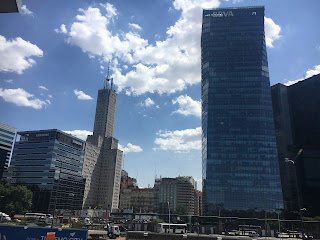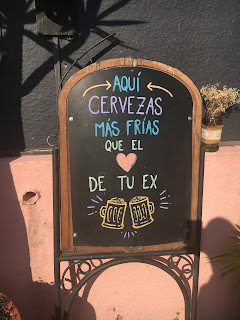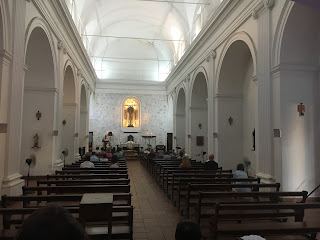Our day began much like the other days we've spent in Buenos Aires, by squishing ourselves into one of our apartment's tiny rickety elevators.
Overall I have a pretty good impression of Buenos Aires. They had a huge European immigrant influx in their history much like the US, and so they have lots of fun influences noticeable in their architecture and their cuisine. I feel like a lot of Latin America is sort of a one note experience in a way. "We were Spanish once now we're not also we have indigenous people. The end."
One of the guidebooks I read said that Argentina was in the top ten richest countries around the time of World War I, even ahead of France and Germany.
We met Lydia's family at a touristy cafe called La Biela and sat outside under a giant tree. The Recoleta neighborhood, and I guess Buenos Aires in general, could pull off touristy without being disgustingly so. I wonder if Argentina is a rich enough country that their tourist industry is aimed at domestic tourists and so still feels authentic to me.
The menu talked a bit about the gigantic rubber tree that shades the cafe's tables. Known as the Gran Gomero, Spanish for "big friggin' rubber tree", it was planted in 1791 by Martín José Altolaguirre and is 50 meters wide. This tree and others like it around town had branches so giant and low to the ground that they were held up by huge metal posts.
Randomly La Biela used to be a meeting-place for racecar drivers and their fans. Biela apparently means "connecting rod", an important piece of an engine that makes it... connect.
I really enjoyed this time as it was a nice chance to relax and debrief each other after the long day of touristing we had yesterday.
It was also a great chance to try my first mate. When I ordered it the waiter thought I said "latte" because he couldn't believe I was so real. Also because my Spanish pronunciation is probably garbage.
The mate came in a fun little package that included the tea, a cup, straw, and a couple of sugar packets. The waiter opened it all up and added hot water in a little ritual that reminded me of reviving a cup of instant ramen.
I'm glad I tried it but I wasn't super blown away. Tasted sort of like tea to me.
There's a crafty fair near the cemetery on the weekends so we poked around there a bit.
One of the guidebooks I read said that Argentina was in the top ten richest countries around the time of World War I, even ahead of France and Germany.
Next we headed to El Ateneo Grand Splendid, a fancy theatre that's been turned into a bookstore.
Books about food, shaped like food. Genius!
The Game of Spanish Life
The big group of us walked a bit to find a particular place to eat lunch. When we got there though we learned that they only accepted cash, which I've learned from multiple signs and conversations is efectivo in Spanish. I asked the waiter in my amazing Spanish if they accepted dollars and he said yes but only 50s and 100s. Cash is the worst.
We hit the stylish Como en Casa as a backup plan.
We'd been discussing what the "milanesa" we kept seeing on menus the past few days might be. Someone hypothesized that it was a pizza which made enough sense to me. So when I spotted it on the menu here I went for it to get to the bottom of this culinary mystery. Well it turns out a milanesa is like a chicken fried steak.
The menu read milanesitas de berenjena and I didn't bother looking up that second word when I ordered. Well berenjena is eggplant. So I ended up with a couple of chicken fried eggplant filets with cheese on top. They were really good.
They had a little courtyard with a fancy fountain.
Lydia and I split from the rest of the gang at this point and headed to the port. We waited too long to buy ferry tickets to Colonia, Uruguay and by the time we checked there were only two left so Lydia and I snagged them. Sacrifices were made. I assume an unsupervised Brandon was just wandering around Buenos Aires panhandling while we were gone.
One the perks of being in Argentina is I never see anyone wearing Cubs gear.
The ferry port was a lot busier than I would've expected. Buquebus was the name of the company and was quite fun to say over and over.
The immigration system from Argentina to Uruguay was awesome. It was two desks side by side and they even handed your passport between the two, stamping it before handing it back. I get a little schadenfreude when the customs officer has to flip through 20 passport pages full of stamps before they can find a place to add their own.
As you can see Uruguay is really close to Buenos Aires, so not going really would have been a crime.
Colonia del Sacramento was a quaint little town with a much slower pace of life than Buenos Aires. I'm really glad we visited and I'm also glad we only stayed for a day trip. There were just too many more exciting things to see back in Argentina.
As you can see Colonia being situated on the border between the Spanish and Portuguese empires was a violent predicament.
Colonia's claim to fame is its renowned Historic Quarter which is a UNESCO World Heritage Site. I'll let the UNESCO website take it from here:
Founded by the Portuguese in 1680, Colonia del Sacramento is located at the tip of a short peninsula with a strategic position on the north shore of the Río de la Plata, facing Buenos Aires. In the region, the Historic Quarter of Colonia is the only example of an urban plan that does not conform to the rigid "checkerboard" grid imposed by Spain under the "Laws of the Indies." Instead, this city has a free plan adapted to the topographical features of the site, although strongly influenced by its military function.
Throughout the successive destructions and occupations of its territory, the Historic Quarter acquired the urban and architectural heterogeneity that characterizes it: to the contributions of the Portuguese and Spanish, were added those of the artisans who emigrated there during the second half of the 19th century.
All of its modest buildings, in regard both to their dimensions and their appearance, are a particularly interesting testimony to the singular fusion of the Portuguese and Spanish traditions that is evident in the construction methods used. The civil and religious buildings with long stone walls, wooden trellis and tiled roofs reveal an excellent knowledge of traditional construction systems and contribute to the architectural unity specific to the Historic Quarter.
The special nature of Colonia del Sacramento is also based on its urban landscape, a mixture of large arteries and large squares, with narrow cobbled streets and more private spaces. The scale of the Historic Quarter is marked by the predominance of single-storey houses, those of two stories being rare. From the bay, only the outlines of the lighthouse and church towers stand out. Surrounded by water on three sides, the relationship of the city to the river is one of the natural aspects that additionally characterizes it.
The bloody border dispute between Portugal and Spain gave this remarkable urban site an identity profile enabling appreciation of the survival of its essential characteristics: the dominant human scale, the texture and the "time" of this unique scenario, and the value of its integration into the environment.
Lydia hadn't had ice cream in about 4 hours so she was jonesing real bad. I call the condition "the dairy scaries".
People in Uruguay love old Coke signs too.
When we popped into La Basílica del Santísimo Sacramento we found some very strange dioramas happening.
Mate, like I tried earlier at the cafe, is also a big deal in Uruguay. It's traditionally drank out of a gourd with a silver straw. As the sign says they call the gourd a bombilla.
There were a lot of gourds with silver straws on sale.
Other countries have the best mailboxes. I can't get enough of them.
A cute thing I read about the people of Uruguay is that they clap when the sun sets. I feel like they have their life priorities in order.
We stopped for a couple refreshments before returning to the ferry. Tannat is like Uruguay's national grape so I went with a bottle of that. It was surprisingly not good. It had kind of a harsh taste, like alcohol or a chemical or something.
As it grew closer to sunset swarms of evacuating dragonflies and windy clouds overhead made me wonder if our nautical voyage home would be unpleasant.
I had fun in Uruguay but I was happy to be back in BA.






































































No comments:
Post a Comment